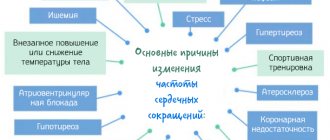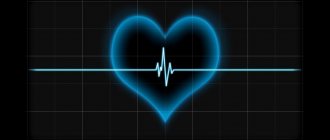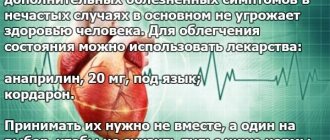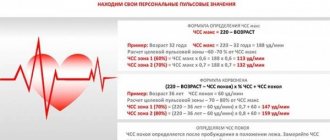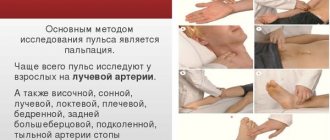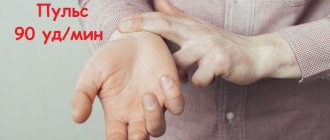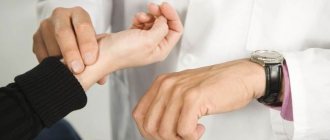High heart rate: what to do?
A high pulse is one that, when measured at rest, is 100 beats per minute or more.
wherein:
- you do not worry at the time of measurement,
- you do not measure your pulse immediately after physical activity,
- your body temperature is normal,
- you are not pregnant (during pregnancy, the pulse increases, but should not exceed 110 beats per minute at rest).
IF THERE IS ANY OF THE ABOVE:
- do not panic,
- Don’t call everyone you know with the question: “High heart rate - what to do?”
- and measure your pulse after half an hour,
- or in case of high temperature after it has decreased;
- Moreover, you need to count the pulse first for 15 seconds, and then for at least a minute in order to understand whether there is an arrhythmia or not. If not, then the result obtained in 15 seconds and multiplied by 4 is the same as what you calculated in a minute.
PATHOLOGICAL CAUSES OF HIGH PULSE RATE:
- Intoxication : you have a fever and/or other signs of an infectious disease (cough, runny nose, shortness of breath).
- Increased activity of the thyroid gland (thyrotoxicosis), which can occur with various thyroid diseases, including cancer.
- Fluid loss : diarrhea, bleeding, ascites (fluid accumulation in the abdominal cavity due to cirrhosis of the liver).
In these cases, you do not need to look for the answer to the question “high pulse - what to do”, but call an ambulance (especially in the case of bleeding from the uterus or from the intestines), while at the same time replacing a small amount of what was lost by ingesting water (applies to bleeding, as it can surgery will be required). If you have diarrhea, you need to drink as much as possible. In these two cases, taking drugs that lower your heart rate will only do harm.
- Heart diseases.
- Anemia . In this case, it is also impossible to reduce the pulse, since this is a reaction to the fact that there is little oxygen carrier in the blood - hemoglobin.
- Excess potassium in the blood or deficiency of magnesium.
WHAT TO DO IF YOU DO NOT KNOW THE REASON, BUT YOU HAVE NO BLOOD OR FLUID LOSS?
- Call an ambulance.
- Drink a few tablets or 30 drops of an alcoholic solution of valerian, you can replace it with motherwort, but do not take the drug “Glycised”, as you may have low blood pressure, and it lowers it even more.
- Place a Validol tablet under your tongue or drop Valocordin drops.
- Take a Magne B6 tablet.
IF THE AMBULANCE TAKES A LONG TIME OR THERE IS NO POSSIBILITY TO CALL IT, AND YOUR PULSE IS HIGH, WHAT TO DO?
- Sit close to fresh air and measure your blood pressure.
- Take a deep breath and strain as you exhale.
- If your heart rate is very high (more than 180 beats per minute), you should cough to prevent atrial fibrillation.
- Press on the eyeballs.
- Press firmly on the dimple in the crook of your left arm where the hand meets the forearm, and, holding this place, hold for about a minute.
- Massage the sides of the neck (where the pulsation of the carotid arteries is felt).
- If you have the drug "Anaprilin", take it under the tongue (so that it contains 20-40 mg: this is either 2-4 tablets of 10 mg, or 0.5-1 tablets, if it contains 40 mg).
IF YOU HAVE ARRHYTHMIA, WHAT TO DO?
If by arrhythmia you mean irregular heartbeats, you need to calculate it within a minute. If the frequency is high (more than 100 beats per minute), you need to call an ambulance .
While she is driving, drinking a tablet of the medicine “Cordarone” or taking “Anaprilin” under the tongue in a dosage of 20-40 mg will help. If this is not the first time you have had such an episode, and you have already taken something (for example, Amlodipine, Digoxin or ATP-Long), take your usual medication.
WHAT TO TAKE FOR HIGH PRESSURE?
Antihypertensive drugs should be selected by a doctor, preferably in a hospital setting, where clear monitoring of your blood pressure is possible . But as an ambulance, if the pressure is above 160/110 mm Hg, you can use medications such as Captopress (1 tablet under the tongue), Enalapril (drink 10 mg, if there is no effect after an hour, more 10 mg). If the pulse is more than 65 beats per minute, you can take the following drugs: Anaprilin, Corvitol, Phenigidine.
Pulse with atrial fibrillation - norm and deviations
Arrhythmia is a disruption of the heart rhythm when this organ begins to contract irregularly. With the development of this pathology, a person’s pulse rate also changes. It can change, both upward and downward. How to normalize the pulse with atrial fibrillation?
How does arrhythmia affect the pulse?
Pulse is the most important physiological indicator of human health, by which experienced specialists can suspect the development of a particular pathology. It is understood as rhythmic fluctuations in the volume of blood vessels, coinciding with the contraction of the ventricles of the heart.
If the pulse rate is disturbed, it means that pathological changes are occurring in the body or it is being affected by external factors. Usually the cause of oscillation failure is heart and vascular diseases. With some diseases the pulse quickens, with others it slows down.
A change in pulse signals a disruption in the functioning of blood vessels and the heart.
Arrhythmia can also be a factor provoking pulse disturbances, both in the direction of decrease and increase. Depending on the pulse rate failure, the pathology is divided into several types. These include the following:
- Tachysystolic arrhythmia. In this case, an increase in the number of vibrations is observed when it reaches 90-100 beats per minute. In some situations the figure may be even higher. It depends on the course of the heart disease
- Bradysystolic arrhythmia. With this type of pathology, the pulse, on the contrary, becomes slower. The number of beats per minute decreases to less than 60.
- Normosystolic arrhythmia. In this situation, the heart rate is close to normal - 60-100 beats per minute.
In most cases, a rapid pulse is observed during atrial fibrillation, when the number of oscillations can reach 500 beats. This condition is accompanied by unpleasant symptoms and requires urgent relief.
Symptoms
With atrial fibrillation, a high heart rate is usually observed. It causes the patient to feel worse. Signs such as:
- General weakness in the body.
- Noise or ringing in the ears.
- Palpable pulsation in the chest and temples.
- Attacks of dizziness.
- Profuse sweating.
- Pre-fainting state.
- Severe anxiety.
- Panic attacks.
When a person develops panic, it is even more difficult for him to cope with an attack of arrhythmia. Poor health in this case is further aggravated.
In addition to rapid heartbeat, atrial fibrillation also causes ringing in the ears and dizziness.
When the heart rate is too low, the following symptoms occur:
- Insomnia.
- Irritability.
- Dizziness.
- Low blood pressure.
- Nausea.
- Cold sweat.
- Impaired movement coordination.
- Loss of consciousness.
It happens that a person does not notice a low heart rate, so you should regularly check this indicator at home.
Treatment methods
The more the arrhythmia develops, the stronger the pulse disturbances become. To get rid of these failures, adequate drug treatment is required. Without them, it will be impossible to restore heart function and vital signs.
In addition to medications, a change in the patient’s lifestyle is required, since poor diet, bad habits, lack of sleep and other external factors negatively affect the condition of the heart.
Nutrition and lifestyle
If a person is diagnosed with atrial fibrillation and a pulse disorder, then first of all he must change his lifestyle and diet. Regarding the first point, doctors recommend the following:
- Stop smoking and drinking alcohol.
- Engage in moderate physical activity.
- Establish a daily routine and avoid lack of sleep.
- Avoid stressful situations.
As for a balanced diet, it is necessary to remove all unhealthy foods from the menu, for example, fatty, fried, smoked, highly salted, sausages, canned food, semi-finished products, confectionery, sweet carbonated drinks. The emphasis should be on fresh vegetables, fruits, berries, herbs, dried fruits, cereals, lean meats and dairy products.
A balanced diet is the basis of a healthy lifestyle for everyone
Drug therapy
You cannot do without taking medications for arrhythmia. Groups of drugs such as:
- Potassium channel blockers.
- Adrenergic blockers.
- Sodium channel blockers.
- Calcium channel blockers.
- Local anesthetics.
- Cardiac glycosides.
- Potassium preparations.
Also, for arrhythmia, anticoagulants are often prescribed, which thin the blood. Indeed, with this pathology, the risk of developing blood clots and thromboembolism increases.
The drug should be selected exclusively by a specialist, since many nuances must be taken into account when prescribing therapy.
The following medications are popular:
- "Amiodarone." Refers to potassium blockers, prevents the penetration of potassium ions into the tissues of the heart muscle. This allows you to slow down the contraction of the heart, and therefore reduce the pulse rate.
- "Novocainamide". Included in the group of sodium blockers, it prevents the entry of this element into the myocardium and reduces the excitability of the heart. This helps normalize your heart rate and pulse.
- "Propranolol." This is an adrenergic blocker that has an antiarrhythmic effect and also helps in stabilizing high blood pressure.
- "Warfarin". Refers to anticoagulants that thin the blood. The drug helps prevent the formation of blood clots during arrhythmia. Its active substance blocks the formation in the liver of components that are responsible for blood clotting.
These are the most basic medications that doctors prefer, but other means can also be used.
Amiodarone is one of the popular medications for normalizing pulse during arrhythmia.
Surgical methods of treatment
A radical way to reduce the pulse during atrial fibrillation is surgery. There are several methods that help get rid of heart problems.
Pacemaker implantation
Installation of a pacemaker is one of the most popular operations, after which the patient’s condition significantly improves. The effect of such treatment lasts for many years, but over time, a new implantation of this device may be necessary.
During the intervention, a pacemaker is implanted under the subcutaneous fatty tissue in the chest area. It is able to interact with the heart muscle using special electrodes, which helps restore normal rhythm.
It is not allowed to perform the operation under such conditions as:
- Infectious processes in the body.
- The period of exacerbation of chronic diseases.
- Mental pathologies due to which the patient cannot adequately interact with doctors.
These contraindications are usually temporary. After eliminating them, you can begin installing the stimulator.
Installing a pacemaker eliminates the problem of arrhythmia, but over time the device needs to be replaced
Radiofrequency ablation
This type of surgical intervention is used for atrial fibrillation quite often and gives a high therapeutic result. The essence of the method is to eliminate the lesions that cause heart rhythm disturbances. These zones are destroyed using high frequency current.
Contraindications to ablation:
- Formation of blood clots in the heart area.
- Carrying a child.
The effect of such an operation is high, but the risk of relapse still remains.
Labyrinth
A therapy called “Labyrinth” is carried out to prevent the passage of a pathological impulse to the heart. To do this, several incisions are made on the vessels of the lungs and the walls of the left atrium. As a result, a kind of labyrinth is formed.
The standard type of such treatment is rarely used because it requires the person to be connected to a heart-lung machine. Another type of similar operation is more often used - “Mini-labyrinth”. In this case, an artificial blood flow system is not required; the entire procedure is performed under local anesthesia. Incisions during this intervention are performed using a radiofrequency catheter.
Whatever surgical intervention is used, the patient must undergo a period of rehabilitation and follow the recommendations of the attending physician.
Traditional methods
If the pulse rate during atrial fibrillation does not exceed 170 beats per minute, then you can try to slow it down using unconventional methods. Tinctures prepared on the basis of hawthorn, motherwort, and valerian help well. They can be purchased at any pharmacy and are inexpensive.
To stop an attack of rapid pulsation, you need to make a mixture of the indicated remedies, taking one teaspoon of each. Pour the resulting liquid into a glass of water and mix well. Drink the prepared product in small sips.
Essential oils also help reduce heart rate. Products made with lavender, cloves, and lemon balm are perfect for this. They can be mixed by taking 10 drops of each, then applied to a handkerchief and inhaled. Oils have a calming effect and help prevent panic.
Aromatherapy allows you to cope with normalizing your pulse during panic attacks
Pulse deficiency due to atrial fibrillation can be eliminated with the help of viburnum decoction. To prepare the product, you need to pour a glass of dried fruits with 200 ml of water, put on fire, and bring to a boil. Then cover with a lid and wait for it to cool. Take 150 ml 3 times a day before meals.
If the pulse is too fast or, conversely, too slow, then folk remedies alone will not do. In this case, medications are needed.
Thus, the pulse during atrial fibrillation is most often rapid, but in some cases, on the contrary, slow. To eliminate the disorder, complex treatment and changes in a person’s lifestyle are required.
Source: https://gipertonia.guru/arterialnoe-davlenie/simptomy/puls-pri-mertsatelnoj-aritmii/
Heart rate during exercise
Monitoring your own heart rate during exercise is one of the best ways to monitor the intensity of your workouts. Most athletes train specifically with heart rate monitors, which is not mandatory. It is enough to use a simple stopwatch or monitor your heart rate with a clock in the gym. What an athlete uses when measuring heart rate (HR) is not particularly important; what is much more important is what the pulse should be during training.
Increased heart rate
Conditions where the pulse is constantly high without a proper reason should puzzle people. When the pulse rises on its own in a calm state, it puts a strong strain on the heart. The norm for a healthy person is 60-90 beats, when the readings are higher, this is a sign of disturbances in the functioning of the body. You need to regularly monitor your pulse rate and, if it is very inconsistent, consult a doctor.
It is believed that heart contractions over 90 per minute are a manifestation of tachycardia.
How to calculate a safe heart rate for sports?
The generally accepted calculation formula is to find the lower and upper limits of the heart rate. This means that training is effective when the pulse is within the boundaries of these two marks - heart rate indicators.
The lower limit is calculated as follows: the athlete’s age is subtracted from the number “200” and multiplied by the indicator “0.6”. If the training athlete is 25 years old, then there are 105 beats per minute. It is not recommended to exercise when your heart rate is below this value, since the benefits from the workout will be minimal.
The upper limit is calculated using a similar formula. The difference is that instead of “0.6” they use the coefficient “0.8”, that is, for a 25-year-old athlete, this figure is equal to 140 beats per minute. It is not recommended to go beyond the upper limit of the heart rate, as this leads to an increase in the load on the heart muscle.
Normal heart rate for men aged 20, 30, 40, 50, 60 years at rest and during physical activity
Heart rate indicators are important when assessing a man’s health status, and its frequency can change under the influence of various factors:
- age;
- growth;
- weight;
- physical activity;
- psycho-emotional state;
- diseases;
- taking certain medications.
The normal heart rate of an adult man depends significantly on his activity and level of physical fitness. It changes when you walk, run, or sleep at night.
The average heart rate at rest is 60 – 90 beats per minute.
We will describe in detail below what pulse is considered normal in a man depending on his age and when his physical condition changes.
Age-related changes in resting heart rate
The heart rate changes as a person ages - in childhood the heart rate is higher, and as you get older it slows down. This happens because boys grow and their metabolism is more active in childhood and adolescence than in adult men.
To estimate the normal heart rate by age in men at rest, use the following table:
Man's age (norms of change by year) Heart rate (pulse beats per minute)
| 16 – 20 years | 65 – 75 |
| 20 – 25 years | 63 – 72 |
| 25 – 30 years | 60 – 70 |
| 35 – 40 years | 60 – 80 |
| 50 – 60 years | 60 – 70 |
| 65 – 70 years | 60 – 75 |
| 75 – 80 years | 60 – 65 |
| from 85 years and older | 55 – 65 |
The heart rate rate for men aged 30 to 50 years is almost the same, since the metabolic rate remains almost unchanged.
Undoubtedly, the degree of training can influence heart rate indicators. This fact is explained by the fact that athletes pump up not only skeletal muscles, but also the myocardium.
In this regard, when contracting, blood is ejected from the heart with greater force and in a larger volume. Because of this, the heart does not need to beat as often as a normal human organ, and the heart rate decreases.
This condition is not a pathology and is considered as a variant of the physiological norm.
In the elderly
in old age, the pulse may slow down, but this change should be assessed as pathological, since in a healthy person the heart rate should remain the same.
in men 60 years of age and older, blood pressure levels usually increase, but pulse values remain virtually unchanged.
in this age period, the normal number of heart contractions largely depends on the individual and should be determined individually depending on the level of training, activity and the presence of concomitant diseases.
How does physical activity affect?
At rest, normal heart rate in men does not change, and their average value remains within 60 – 80 beats per minute.
Heart rate measurement should be performed only against a background of complete physical rest and carried out in a sitting position no earlier than 20 - 40 minutes after physical activity or training (the time interval depends on the intensity of the activity).
During sleep
A person's sleep is replaced by slow and fast phases, which form one cycle, lasting approximately 90 minutes. During the night, a person undergoes from 4 to 6 such cycles. The slow phase is divided into shallow and deep sleep.
The normal heart rate during sleep in men does not have a clearly defined limit; during the night it can slow down to 50 beats per minute or lower.
However, this indicator is not constant for the entire sleep period. The heart rate at this time may vary depending on the stage of sleep and brain activity.
During light sleep, brain activity decreases and the heart rate drops to a minimum. After the onset of deep sleep, the indicators begin to increase and reach their maximum values in the REM sleep phase. Sometimes during this period the heart rate can be even higher than during wakefulness.
When walking
When walking, heart rate increases depending on fitness and step speed. For example, in athletes it can increase to only 90 beats, and in sedentary men it can rise to 110 - 120 beats per minute.
The normal heart rate for men when walking is calculated using the formula: subtract age from 180, the resulting result will be the upper acceptable limit.
Approximate heart rate indicators when walking can be checked with this table:
Type of loadDegree of loadPulse rate
| standing | Minimum | 80 – 100 |
| Walking tour | Very light | 100 – 110 |
| Quick step | Lightweight | 110 – 130 |
While running
During running, processes similar to walking occur in the body, the only difference between running and walking is the absence of a double support phase and a higher intensity of muscle load.
The normal heart rate when running for men is determined by the following formula - subtract age from 220, thus we will find out the maximum permissible heart rate for your age.
Approximate heart rate values while running can be checked with this table:
Load Degree of load Pulse rate
| Jogging | Average | 130 – 150 |
| Run | Heavy | 150 – 170 |
| Running with load | Very heavy | 170 – 190 |
Acceptable limits
During physical activity, heart rate indicators in men have not only normal values, but also maximum permissible limits.
Heart rate norms during physical activity have maximum limits, beyond which it is not recommended for those people who are amateurs and engage in physical exercise for health to go beyond it during training.
Approximate average and maximum heart rates in men can be checked with this table:
Age of the man Average heart rate values Maximum permissible heart rate values
| 18-20 years old | 130 – 160 | 200 |
| 25 years | 127 – 156 | 195 |
| 30 years | 124 – 152 | 190 |
| 35 years | 120 – 148 | 185 |
| 40 years | 117 – 144 | 180 |
| 45 years | 114 – 140 | 175 |
| 50 years | 111 – 136 | 170 |
| 55 years | 107 – 132 | 165 |
| 60 years | 104 – 128 | 160 |
| 65 years and older | 98 – 120 | 150 |
For professional athletes, the normal heart rate limits during exercise are much higher than average.
Heart function assessment
To assess the work of the heart, not only the pulse is measured at rest and during physical activity, but also the Rufier functional test. During this load complex, three measurements of the heart rate are performed.
The first measurement is taken in a lying or sitting position and is recorded as reading A. After this, the subject is asked to perform 30 deep squats in 45 seconds. Next, a second measurement is performed and recorded as indicator B. After 1 minute, the pulse is counted one more time and recorded as indicator C.
The Ruffier test value is calculated using the formula: 200 is subtracted from the sum of indicators A, B and C and the result is divided by 10.
The Ruffier index is assessed as follows:
- 0 – excellent indicator;
- from 1 to 5 – a good indicator;
- from 6 to 10 – satisfactory indicator;
- from 11 to 15 – unsatisfactory indicator (or average heart failure);
- 15 or more is an extremely poor indicator (or severe heart failure).
Types of pulse disorders
An acceleration or deceleration of the pulse in men at any age indicates disturbances in the functioning of the heart, which can be caused either by pathologies of the cardiovascular system, along with diseases of other systems and organs, or by a natural physiological state.
An increase in heart rate to 100 beats per minute or higher is called tachycardia.
Tachycardia in men can be provoked by physiological or pathological reasons.
A slowing of the heart rate to 50 beats per minute or below is called bradycardia.
Like tachycardia, it can be caused both by natural physiological processes in the body and by pathological causes hazardous to health.
That is why the identification of pathological symptoms should always be a reason to consult a doctor who can find out the cause of disturbances in the heart rate.
While determining the symptoms of changes in heart rate of a natural physiological nature, you can eliminate it yourself.
Physiological tachycardia
Physiological tachycardia is caused by the following conditions:
- physical overload;
- stressful situation;
- cold;
- strong pain;
- taking certain medications.
After exposure to physiological causes, the heart rate increases for some time, and after the influence of the factor ceases, the heart rate returns to normal.
Pathological tachycardia
Pathological tachycardia is observed for a long time and is associated with disturbances in the functioning of the heart and other systems and organs. Increased heart rate in such cases can be caused by the following reasons:
- hypertonic disease;
- cardiac ischemia;
- myocardial pathologies and heart defects;
- disturbances in the functioning of the autonomic nervous system;
- bacterial and viral infections accompanied by fever;
- endocrine pathologies;
- bleeding;
- poisoning with toxic substances or drug overdose;
- oncological diseases.
With pathological tachycardia, in addition to increased heart rate, a person experiences the following symptoms:
- heartbeat;
- feeling of heaviness or pain in the chest;
- shortness of breath and feelings of lack of oxygen;
- frequent dizziness;
- increased fatigue;
- sleep disorders;
- fainting (sometimes).
Physiological bradycardia
Physiological bradycardia is observed in the following conditions:
- physical fitness of athletes or people engaged in heavy physical labor;
- night sleep;
- psycho-emotional or physical fatigue;
- physical impact on reflex zones (a tight collar of a shirt or a tightly tied tie compresses the vagus nerve, pressure on the eyeballs);
- slight hypothermia or exposure to high humidity and heat;
- taking certain medications (the general state of health does not change).
Sometimes a person may experience so-called idiopathic bradycardia, in which the general state of health does not change in any way and doctors cannot find out the reason for the slowing of the pulse. With physiological bradycardia, heart rate returns to normal after the cessation of exposure to the factors causing it, and treatment for this condition is not required.
Heart rate during cardio training
Measuring your heart rate using a stopwatch while running is an almost impossible task. And if an athlete is into cardio, then he should purchase a heart rate monitor for jogging outside and use the monitoring devices built into exercise bikes and treadmills.
When the goal of cardio is to burn body fat, your heart rate should be between 120 and 150 beats per minute . Bodybuilders should follow a slightly different regimen to preserve muscle. Cardio should be low-intensity, that is, within a session lasting 50-60 minutes, the pulse should be in the 120-130 beats mode.
What to do to lower your heart rate?
To lower your pulse, you can put a Validol tablet under your tongue, bend your head down and breathe in fresh air.
If the pulse is 120 beats/min. occurs at rest and stays above 15 minutes, which means that measures need to be taken to reduce it. At the first stage, you need to call an ambulance. Before the doctors arrive, you can put Validol or Valocordin under your tongue without chewing or swallowing. To alleviate the condition, you can sit down, bend your head slightly and massage your neck. It is advisable to open the window for ventilation and fresh air. With a short-term increase in heart rate, you can cope with the problem by adjusting your lifestyle, normalizing your diet, eliminating alcohol and nicotine from your life, playing sports and choosing the optimal work and rest schedule.
Return to contents
Treatment of the disease
When treating tachycardia, blood pressure readings are initially measured, since they are interdependent. To quickly stabilize heart pressure, you can drink Metoprolol, Furosemide or Verapamil. If blood pressure is high, use “light” medications - valerian, motherwort, Valocordin or Corvalol. Having determined the nature of the increased heart rate, the doctor eliminates the cause of the disease, rather than slowing down the pulse. It is possible to use anti-inflammatory drugs and antibiotics. Doctors often use electropulse therapy to get rid of the disease.
In folk medicine, decoctions based on rose hips, motherwort, and valerian root are used. In addition to the recipe there is honey, which acts as a panacea for many diseases. These natural ingredients are brewed or infused in water. They are used for both prevention and treatment. But if the situation is chronic, then tachycardia must be treated with medications to avoid death.
etodavlenie.ru
Pulse during strength training
Experienced athletes do not recommend raising your heart rate to the upper limits. The ideal heart rate is considered to be a limit of 120-140 beats per minute , maintained from the beginning to the end of the workout. It is necessary to avoid dropping the heart rate below the lower limit, which is why rest between approaches should not be done for more than a minute.
It is not recommended to lift the barbell at maximum heart rate. You must try to keep it within 130 beats throughout the training. This will strengthen the heart muscle, increasing the effectiveness and efficiency of strength training.
Pulse from 140 to 170 beats, what does it mean and what to do to treat heart rate?
What to do if your heart rate is 110 beats per minute? The first thing to do is try to determine if it is related to coffee, an energy drink, or some kind of medication. In this case, it is enough to just wait quietly for about an hour. If tachycardia is caused by stress, you can take a sedative - motherwort tincture, Corvalol. If you have palpitations due to physical activity, it is enough to rest for 5 to 10 minutes for your heart rate to return to normal.
If a pulse of 110 per minute appears regularly, you should consult a doctor. Treatment depends on the cause of the rapid pulse:
- for hyperthyroidism, thyreostatics are prescribed - medications that inhibit the synthesis of thyroid hormones; if necessary, treatment with radioactive iodine or surgical removal of part of the gland is used;
- for cardiac arrhythmias, a variety of drugs are prescribed, for example, beta-blockers, calcium antagonists, sinus node I-channel antagonists, cordarone; in some cases, catheter radiofrequency ablation is indicated (a minimally invasive procedure by which the doctor destroys the area of abnormal impulses that cause the heartbeat); at the same time, anticoagulants and/or antiplatelet agents are often prescribed to prevent the formation of blood clots in the cardiac cavities;
- if increased heart rate is caused by lung diseases, proper treatment is necessary - antibiotics, bronchodilators, etc.
You need to call an ambulance in cases where the pulse is 110 beats per minute or more, accompanied by the following symptoms:
- pressing, burning, squeezing pain behind the sternum;
- severe headache, loss of consciousness;
- sudden shortness of breath, cough, chest pain;
- weakness, pale skin, cold sweat, vomiting “coffee grounds” or blood, black loose stools;
- a rapid increase in blood pressure if a person does not know how to cope with it on his own.
Features of heart rate when running
Running is a physical activity. It can be of different intensity. Your heart rate when running will depend on how actively you force your body to work.
The faster you run, the more nutrients and oxygen your muscles consume. This means that the faster these substances need to be delivered to the muscles along with the blood. And, accordingly, the faster your heart should beat.
Physiologically, different processes occur at different speeds of the heart.
For example, as the heart rate increases, the volume of blood that the heart pumps into the bloodstream per beat increases. Naturally, this increase cannot continue indefinitely. And the limit is reached at approximately 120 beats per minute (with an individual adjustment of plus or minus 5 beats).
By the way, this heartbeat is characteristic of health-improving running. A more frequent rhythm is considered a training rhythm.
A diagnosis was made: sinus arrhythmia. What should I do?
The heart is a mysterious and important organ, the phenomena of which have not yet been fully studied. However, what is already known about it is of great interest to every person for whom the state of their health is important. One of the interesting phenomena of our motor is sinus arrhythmia.
- Causes of heart failure
- Classification
- Diagnostics
- Is it possible to get rid of this disease?
- Heart rhythm disturbances in children
It manifests itself in connection with heart contractions, between which there are no equal intervals. Of course, for healthy people, the process manifested in increased or slowed heart activity, which is associated with the respiratory system, is quite normal. However, this process may have a pathological uneven nature of contractions, which often indicates diseases associated with the cardiovascular system, such as heart attack, ischemia, rheumatism, and so on. This may also indicate neuroses and excessive use of medications.
Causes of heart failure
There are three main reasons why this type of arrhythmia occurs.
- Violation of the electrolyte composition of the blood. This is due to the fact that the required amount of magnesium, potassium and calcium is not delivered. If there is a lack of magnesium or potassium, the heart muscle does not relax as it should. Due to the spasm, it does not receive oxygen and important nutrients supplied by the blood. If there is not enough potassium, the heart cell contains excess water and sodium, causing it to swell and function poorly. Due to the fact that contractile function is impaired, the heart rhythm becomes erratic, which can subsequently lead to heart failure.
- The sinoatrial node functions worse with age. This may be associated with liver disease, hypothermia, typhus, brucellosis, hypothyroidism, other arrhythmias, and senile amyloid degeneration.
- One of the forms of sinus pathology is bradyarrhythmia, which can be associated with an acute form of oxygen starvation, high blood pressure, too much blood acidity and some other conditions.
Classification
Sinus arrhythmia can be divided into three types.
- Tachyarrhythmia. This condition is determined by a heart rate that is more than 80 heart beats per minute. It is normal for such an increased number of heart contractions to occur during excitement, stress, anxiety or physical activity, such as sports. If such a situation is observed at rest, this is a manifestation of this type of arrhythmia. This is a symptom of the disease. It is necessary to identify the causes of the rapid pulse, after which the doctor will prescribe treatment. It may be necessary to carry out diagnostics, such as an ECG. Very often, this type of arrhythmia indicates problems in the blood circulation, autonomic nervous system and thyroid gland, which can be combated by properly selected treatment.
Sinus tachyarrhythmia is dangerous because the heart, during hard work, is not filled with blood in the required volume. Because of this, the blood supply to tissues and organs and the heart muscle itself deteriorates. Blood pressure may also decrease. Myocardial ischemia may occur, and subsequently cardiac ischemia and heart attack. Symptoms of tachyarrhythmia, as already mentioned, are a rapid pulse, more than 80 beats, as well as a feeling of our motor beating.
- Bradyarrhythmia. In this case, the heart rate is less than 60 beats per minute. The prerequisites are sclerotic changes in the myocardium, endocrine disorders, myocarditis, cardiac ischemia, prolonged fasting, and a weak sinus node. Hypoxia of the brain and impaired blood circulation contribute to the development of sinus arrhythmia. Symptoms of sinus bradycardia, in addition to low heart rate, are the following: dizziness, weakness, heart pain, fainting. This does not mean that they all have to appear. If the heart rate is below 40 beats, not only fainting, but also cardiac arrest may occur.
Heart rate too slow
- Extrasystole. This type of arrhythmia means that a particular area of the heart muscle or the entire heart muscle contracts prematurely. This can occur due to potassium deficiency, psycho-emotional overload, smoking and excessive consumption of coffee or tea. In addition, the causes may be myocardial damage caused by cardiosclerosis, ischemia or myocardial dystrophy. Symptoms of sinus extrasystole are as follows: cardiac arrest, unexpected tremors, a feeling of anxiety, a feeling of lack of air. Due to frequent extrasystoles, cardiac output decreases, which reduces blood flow in the coronary, renal and cerebral arteries. Cerebral circulation is also impaired and angina appears. Symptoms of the disease can be reduced by giving up bad habits and establishing proper nutrition.
A particular area of the heart muscle contracts prematurely
Diagnostics
The first thing used to diagnose a disease is an ECG. This is a very accessible and informative method with which you can quickly obtain the data needed to assess the condition of the heart. If you correctly interpret the ECG data, you can understand what arrhythmia is bothering the patient. The work of the heart muscle is recorded from the surface of the patient's body. Special electrodes are placed on his chest, legs and arms. There are 10 of them in total. The procedure lasts no more than ten minutes. An ECG allows you to monitor the state of arrhythmia and read the frequency of contractions.
Severe sinus arrhythmia is also monitored by this form of diagnosis. This sinus manifestation is related to breathing. The contraction frequency increases with inhalation and decreases with exhalation. Very often this form occurs in children or adolescents, as it is associated with the fact that the autonomic system is unstable.
The only ECG sign that allows one to distinguish regular sinus rhythm from sinus arrhythmia is a gradual shortening of the RR intervals associated with an increase in the rhythm, as well as a lengthening of the RR intervals associated with a decrease in the rhythm. Such fluctuations are often related to the phases of breathing and exceed 0.15 seconds.
Sometimes portable devices that are attached to the patient’s body are used to detect arrhythmia. They record ECGs throughout the day. Thanks to this diagnostic method, rhythm disturbances are recorded during this period of time. Laboratory tests and ultrasound of the heart may also be prescribed, which can help identify the causes of sinus pathology. It is very important for the doctor to have a conversation with the patient, who will tell him all the symptoms that are bothering him, which will also help make a diagnosis and prescribe treatment.
Is it possible to get rid of this disease?
To eliminate sinus pathology, you need to consult a doctor who will give the necessary recommendations, conduct an examination and, if necessary, prescribe treatment. Drug intervention may not be necessary. A diet rich in potassium, a balanced attitude towards work and rest, and sports are very important. Again, all physical activities should be discussed with your doctor. Sometimes treatment may include mild sedatives, which are usually of herbal origin. If this arrhythmia indicates the development of other diseases, the doctor will prescribe their treatment.
However, it is best to try to prevent the development of arrhythmia. To do this, you need to lead a healthy lifestyle, which includes moderate exercise, proper nutrition, giving up bad habits, avoiding stress and losing weight if it is excess.
Heart rhythm disturbances in children
Sinus arrhythmia in children is a pathological change in heart rhythm. However, children do not encounter it very often. To diagnose this disease in children, an ECG is also performed. If the disease is pronounced, serious consequences can occur. For example, the circulatory system may be underdeveloped. However, in children, arrhythmia in most cases goes away over time.
Sometimes sinus arrhythmia in children can persist for years. In order to avoid health problems, your baby can be given gentle physical activity. You should definitely consult a doctor who, if necessary, will prescribe effective treatment.
If you experience the symptoms discussed in this article, you do not need to self-medicate. A visit to the doctor will be much more beneficial, especially if you follow all his recommendations and lead a healthy lifestyle.
– by leaving a comment, you accept the User Agreement
- Arrhythmia
- Atherosclerosis
- Varicose veins
- Varicocele
- Vienna
- Haemorrhoids
- Hypertension
- Hypotension
- Diagnostics
- Dystonia
- Stroke
- Heart attack
- Ischemia
- Blood
- Operations
- Heart
- Vessels
- Angina pectoris
- Tachycardia
- Thrombosis and thrombophlebitis
- Heart tea
- Hypertension
- Pressure bracelet
- Normalife
- Allapinin
- Asparkam
- Detralex
Processes in the body at different heart rates
Easy running and 120–130 beats per minute
A rate of 120 beats per minute is comfortable for the heart. Nature has designed it so that at this frequency the cells have enough blood and oxygen to carry out aerobic activity.
This means that such running will not change your anaerobic threshold in any way, will not cause the formation of lactic acid and will not significantly affect the condition of your muscles.
The last statement is true, since such a heart rhythm can be maintained by mixing walking and running. That is, you will not be able to exhaust the body as much as, for example, with a heart rate of 140–150 beats per minute.
What are the benefits of a heart rate of 120 beats?
- The heart muscle is trained. Blood supply to all organs and tissues improves. This is extremely important for the central nervous system, since its functioning directly depends on the blood supply. It turns out to prevent stroke and other unpleasant diseases. It has been experimentally proven that attention acuity and memory are better in those who train their hearts in the fresh air to 120–125 beats per minute.
- Lactic acid is removed from the body (if you, in addition to running, do heavy training).
- At the number 120–130 is the so-called fat burning threshold. That is, this is the heart rate level at which the body begins to use fats instead of carbohydrates to extract energy. This is why running training with a constant rhythm of 120–130 beats is useful. Please note that you need to run for a long time - from 20 minutes to an hour. Then it will make sense.
Thus, a running heart rate of 120 beats per minute is healthy.
It is suitable for those people who run for pleasure, without setting goals to improve their running performance.
In general, running training requires a special program, which a competent coach can create. And this program is selected individually. You won’t find your exact option on the Internet – it simply doesn’t exist, it needs to be compiled specifically for your specific needs.
Also, keep in mind that you won’t be able to hold 120 hits all the time. There will be slides - on the rise, the heart will speed up, the body will feel heavy. To make it easier to keep your heart rate at the same level, you can combine running with walking on more difficult sections.
Preventing increased heart rate
What are the health risks of a pulse of 110-114 beats per minute? If it occurs in response to stress or strain, there is no danger. At rest, the heartbeat returns to normal. However, during its increase, a person may experience the following sensations:
- dizziness and fainting;
- severe weakness;
- feeling of heartbeat, pulsation in the body;
- dyspnea.
If a rapid pulse is caused by a disease, additional symptoms characteristic of this disease occur. For example, with hyperthyroidism, irritability, insomnia, sweating, and muscle tremors appear. Palpitations caused by pathology of the heart or lungs are often accompanied by chest pain, shortness of breath, and dizziness.
Thus, a pulse of 110 per minute in itself does not pose any particular danger to the heart. However, the diseases in which it occurs can lead to various complications. Therefore, with such heartbeat and pulse at rest, it is necessary to consult a general practitioner.
Pulse readings are very important in determining a person's health status. They indicate possible abnormalities in the functioning of the heart, blood vessels and throughout the body. The cause of a high heart rate may be a stressful situation or a violation of acceptable physical activity. But in some cases, such a phenomenon signals serious pathological changes that require immediate examination and subsequent treatment.
It is unlikely that a healthy person would be bothered by this issue. But you should know that 60 to 90 beats per minute is considered normal. The frequency largely depends on the functioning of the body's systems, as well as on age and occupation.
For example, women have 6-9 more strokes than men of the same age group. In athletes, these indicators can be 40-50 units, since the heart muscle is quite well developed. Intensive metabolism in children under one year old explains the high rates - 120-140. With age, the frequency of oscillations gradually changes in a child, at 14 years old it reaches 75-85 beats within 60 seconds. For older people, the pulse may be below 60.
At any age (except for children), a pulse above 90 indicates tachycardia, that is, the inability of the heart muscle to carry out normal blood circulation. A pulse exceeding 120 beats is considered especially dangerous. Such manifestations should be a reason to consult a doctor in order to prevent the development of complex diseases.
To normalize your pulse at home, without using medications, you can use the following advice from doctors:
- Exercise regularly
Consistent moderate exercise reduces heart rate and the risk of heart disease. Regular exercise has been proven to help lower your heart rate at home. The best activities for this are jogging, cycling, swimming and walking. You need to exercise at least 30 minutes a day, 5 days a week.
Food should contain sufficient amounts of calcium, potassium and magnesium. It is necessary to avoid excessive salt consumption and also give preference to protein foods. Whole grain cereals, dairy products, fruits, raisins, spinach, and figs are healthy. Folic acid should be added to the diet. All of these foods support heart health and strength.
This is one of the main ways to lower your heart rate at home. Reducing body weight to normal will certainly lead to a decrease in heart rate, since the heart will no longer experience significant stress.
Caffeine, found not only in coffee, but also in black and even green tea, increases blood pressure and increases heart rate. Avoiding daily consumption of these drinks will help you gradually lower your heart rate at home.
Smoking not only increases the risk of heart disease and hypertension, but is also accompanied by increased heart rate due to oxygen deprivation. In addition, a bad habit leads to a decrease in physical endurance and makes it difficult to engage in physical exercise.
- Learn to deal with stress
Nervous tension leads to excitation of the sympathetic nervous system, which accelerates the heart rate. If a person has a rapid pulse, at home he just needs to lie down, close his eyes and concentrate on a pleasant thought; You can do yoga or breathing exercises.
- Sleep at least 7 hours a night
A full sleep for 7 – 8 hours normalizes the state of the nervous system. If you snore or have sudden awakenings at night, you should consult a cardiologist and have sleep apnea diagnosed. This condition is accompanied by short-term pauses in breathing during sleep, serves as a risk factor for heart and endocrine diseases, and also does not allow a person to rest normally at night.
- Don't give up chocolate
In small quantities, chocolate and cocoa reduce heart rate.
- Use herbal remedies
To reduce the likelihood of diseases of the heart and other organs, strengthen the heart muscle, and prevent the development of certain arrhythmias, you can use traditional medicine recipes. These remedies will not help to quickly reduce your heart rate, but they can help prevent pathology.
A mixture of honey, walnuts, dried apricots and raisins is good for the heart. It can be taken one teaspoon 2 times a day. It is recommended to add black currant and mint leaves, rose hips and hawthorn berries to regular tea.
Author of the article: Practicing physician V. O. Chubeiko. Higher medical education (Omsk State Medical University with honors, academic degree: “Candidate of Medical Sciences”).
Take the TEST: Do you have tachycardia?
What happens to the heart after running
Everyone talks about what your heart rate should be while running. It is clear that when running, the heart rate is accelerated. What about after running?
The faster your rhythm returns to your normal heart rate (60-70 beats per minute), the better shape you are. A beginner’s pulse fluctuates for quite a long time after a race, and he also experiences chest colic and shortness of breath. For them, a fast race is stressful (you can see an example in any school gym during physical education classes).
The athlete's rhythm is restored within 60–120 seconds. Even if you start running after a long break, within a couple of weeks you will notice how much faster and easier your heart recovers after running.
Depending on your well-being and fitness, you need to maintain a different running pace. Here are some recommendations if you run for your health or fat loss:
- The running should not be fast. You can run on the verge of walking if it is still difficult for you to maintain a speed of 8–10 km per hour.
- If you experience any discomfort or shortness of breath, take a step. If your heart or its area tingles, also take a step, gradually slowing down. Depending on how you feel further, either continue running or finish it for today (this happens when you start quickly).
- What is the normal heart rate for you when running? Focus on your well-being. If you are comfortable and at the same time you feel a slight strain, then this is a normal state for you. The pulse can be 110, or maybe 130. Faster ri up to 120 beats.
- The running pace should be such that you, again, feel comfortable.
Blood pressure 150 over 100: reasons and what to do?
Have you been struggling with HYPERTENSION for many years without success?
Head of the Institute: “You will be amazed at how easy it is to cure hypertension by taking it every day...
Read more "
Blood pressure (BP) is one of the most important indicators of the health of the cardiovascular system and the body as a whole. It indicates the force with which blood presses on the walls of blood vessels. Sometimes, especially older people, when feeling unwell, they measure their blood pressure and get extremely high readings. What could be the reasons for pressure 150 to 100 and what to do in such a situation?
- Causes
- What to do at home
- What to do during pregnancy
| Causes of high lower blood pressure |
| Systolic and diastolic pressure |
24-hour blood pressure monitoring – where can it be done? What heart pressure is considered elevated: normal table Systolic blood pressure: what it is and how to treat abnormalities
Normal blood pressure is considered to be 120 over 80. Depending on the person’s build and any individual characteristics, slight deviations from the ideal values are possible. With age, normal blood pressure levels may increase slightly - this is due to the occurrence of various chronic diseases and the aging of the body as a whole.
A condition when blood pressure greatly exceeds 120 over 80 is called hypertension. In most cases, it is only a consequence of some existing pathology of the cardiovascular system. If you experience symptoms and signs of high blood pressure, you should definitely contact a cardiologist.
A blood pressure reading of 150 over 100–90 or higher is extremely negative. At older ages, its occurrence is more expected, since older people are more prone to such pathologies of the heart and blood vessels. However, if such pressure occurs in a young person, this can be an extremely dangerous sign.
It is also worth mentioning the main symptoms of a hypertensive crisis. If they occur, you should immediately consult a doctor. However, if the condition rapidly worsens, you may need to call an ambulance. Sometimes a crisis quickly leads to a heart attack or other acute condition that can lead to death.
Symptoms of the pathology:
- Severe dizziness, headache, impaired coordination of movements.
- Nausea, sometimes leading to vomiting, blurred vision, appearance of “stars” and “floaters” before the eyes.
- Rapid or slow pulse, pain on the left side of the sternum, difficulty breathing, shortness of breath, lightheadedness.
Such signs are extremely alarming and indicate a hypertensive crisis. In this case, the pressure always rises to around 150 to 100. If such indicators occur without symptoms of heart disease, you should still visit a cardiologist.
It is also usually recommended to measure your pulse. The heart rate indicator together with blood pressure values will give a complete picture of the processes occurring in the body during hypertension. If, with a pressure of 150 to 100, the pulse is 100 or even higher, this is an extremely negative indicator. An increased pulse often occurs during a hypertensive crisis.
If, with a pressure of 150 over 100, the pulse is 60 (within the normal range), this may not indicate anything specific. In some cases, with hypertension, heart rate indicators do not change much. If bradycardia occurs, i.e. a condition when the pulse is significantly below normal, this is not always associated with an increase in blood pressure values.
Causes
In most cases, if blood pressure readings reach this level, it is worth talking about a hypertensive crisis. This term refers to an exacerbation of hypertension, when blood pressure levels reach the maximum possible level and a lot of different severe symptoms appear. A hypertensive crisis can be isolated if treated immediately after its occurrence. It can also recur (sometimes quite often) if treatment has not been started.
In general, the following diseases and conditions can lead to hypertension and provoke a hypertensive crisis:
Why do you feed pharmacies if hypertension is afraid of the usual like fire...
Tabakov has revealed a unique remedy against hypertension! To reduce blood pressure while preserving blood vessels, add to…
Age can also be considered as a factor. The older a person is, the higher the likelihood of developing hypertension. Although recently, experts are increasingly diagnosing this disease in fairly young people.
Pregnancy can be considered another factor. A woman's blood pressure level is always slightly higher than normal, but if it is very high and symptoms of hypertension are present, the pregnant woman's condition must be monitored by a specialist.
What to do at home
In case of a severe attack of hypertension, it is important to competently reduce blood pressure readings that are too high. You can use home and traditional medicines only for isolated attacks of high blood pressure. If hypertension is present on an ongoing basis, you should definitely contact a cardiologist, find out the cause of this condition and select the appropriate medications.
It is worth considering that even after a single hypertensive crisis, it is important to pay attention to your lifestyle. After an increase in blood pressure, you usually need to switch to a healthy diet, which completely excludes salty, fatty foods, as well as dishes that contain a lot of spices. You should avoid foods and drinks that can raise your blood pressure.
During an attack of high blood pressure, you should lie down or sit down, put things aside, and breathe deeply. You can drink warm water. It is not recommended to take any medications on your own. But to relieve the symptoms, you can take Corvalol or Andipal, an antispasmodic that relieves the effects of hypertension. You can take medications only strictly according to the instructions. After taking it, you should wait for the drugs to take effect.
If you consult a specialist with persistent hypertension, you will be prescribed a whole range of different medications that help completely cope with the manifestations of the disease. It is worth noting that hypertension is usually a chronic diagnosis; it is only important to avoid exacerbations. The following groups of drugs are usually prescribed:
- diuretics, which help remove excess fluid from the body, which lowers blood pressure;
- beta blockers, which reduce the load on the heart;
- ACE inhibitors, which help dilate blood vessels;
- calcium antagonists, which are prescribed if arrhythmia occurs with hypertension.
Folk remedies can also help cope with pressure. First of all, you can pay attention to decoctions and infusions of various medicinal herbs with a sedative effect: valerian, motherwort, sage, mint, chamomile. It is enough to brew a couple of tablespoons of dried herb in 0.5 liters of water and let it brew for 15–25 minutes. Take half a glass several times a day.
In addition, garlic helps with increased blood pressure. It should be eaten in its pure form, with a snack of bread, or added to food. You can cut into small slices and bake in the oven for a few minutes. Dried slices also help lower blood pressure, but do not fully retain the pungent smell and taste. Roasted garlic is just as effective as fresh garlic.
What to do during pregnancy
If hypertension occurs during pregnancy, it is advisable to immediately consult your doctor. A slight increase in blood pressure during pregnancy may be normal, but in any case the condition must be constantly monitored. It is worth considering that most medications against hypertension cannot be taken during pregnancy.
A pregnant woman with high blood pressure should avoid physical activity and stress, as they can trigger an attack of hypertension. You need to eat a healthy diet and drink enough fluids. To maintain normal values, you can use herbal infusions and decoctions - medications cannot be taken during pregnancy.
Emergency care for tachycardia
There are many antiarrhythmic drugs, but it is not advisable to use them on your own at home. Medicines have different principles of action, the effectiveness of the medicine depends on the cause of the disease.
If you experience increased heartbeat, regardless of physical activity, or consumption of foods that cause increased heart rate, you should call an ambulance. Until the doctors arrive, you should take the following measures yourself:
- Lie down and try to calm down. Try not to listen to how your heart is beating, start thinking about something pleasant. Anxiety and worry, worries about when the doctor will finally arrive will lead to a deterioration in your health.
- Drink warm tea with lemon balm, motherwort and valerian, if you are not allergic to these herbs.
- Validol will help to urgently relieve heart pain and tachycardia. The tablet must be placed under the tongue, so it will act faster and more effectively. You can use nitroglycerin instead of validol if there are no contraindications.
- 30 drops of Corvalol, valocormid or valocardine can not only reduce the heart rate, but also dilate blood vessels. Such measures will help prevent the occurrence of stroke or myocardial infarction.
You can calm your heartbeat using reflex treatment methods aimed at increasing the tone of the vagus nerve:
- hold your breath with straining at the height of inspiration for 5-10 seconds;
- apply moderate pressure with your thumbs for 5 seconds on the eyes under the supraorbital arches;
- Immerse your face in cold water and hold your breath for 20 seconds.
The doctor will prescribe serious antiarrhythmic drugs after the examination. Most often, intravenous administration is recommended:
If medication and reflex treatment do not help, then electrical defibrillation is performed.
After conducting an examination and determining the cause of tachycardia, the doctor prescribes a therapeutic course. If the disease is not severe, then treatment can be carried out at home.
